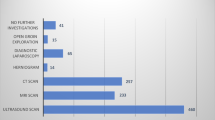Abstract
Tension-free hernioplasty is performed using prosthetic material in one-half of hernia repair procedures in Poland but in 85% of those in the region of Pomerania. This questionnaire study of surgeons in Pomerania examined their sources of knowledge about and the factors influencing their choice of groin hernia surgery. The questionnaire was sent to surgeons from 19 hospitals and was answered by 109 (83% of hernia surgeons in the region). We analyzed their reported knowledge of particular operative techniques, factors important in selecting the technique (personal experience, trends in surgical center), and the available sources of information (e.g., medical literature, internet, information from teachers, sales representatives). All respondents reported being familiar with and able to perform tension-free techniques, but only 44% are influenced by their individual professional skills in selecting the technique. Another 44% base their decision on trends in their hospital, and only 22% consider the patient’s preferences. The most frequently quoted sources of scientific information are articles in the medical literature and conference reports (90%). Only 8% of the respondents are governed in their professional work by information from pharmaceutical company representatives. Most surgeons (70%) would prefer to make a decision about using a new surgical technique after practical training sessions or workshops led by experienced colleagues. In contrast to common opinion, the information from sales representatives are of only minor importance compared to that of evidence-based data and attendance at workshops and courses.
Similar content being viewed by others
References
Bay-Nielsen M, Kehlet H, Strand L, Malmstrom J, Heideman Andersen F, Wara P, Juul P, Callesen T (2001) Quality assessement of 26304 herniorraphies in Denemark: a prospective nationwide study. Lancet 358:1124–1128
EU Hernia Trialists Collaboration (2002) Repair of groin hernia with synthetic mesh (Meta analysis of randomized controlled trials). Ann Surg 233:3:322–332
Grant AM (2002) Laparoscopic versus open groin hernia repair: meta-analysis of randomised trials based on individual patient data. The EU Hernia Trialists Collaboration. Hernia 6:2–10
Hetzer FH, Hotz T, Steinke W, Schlumpf R, Decurtins R, Largiader F (1999) Gold standard for inguinal hernia repair: Shouldice or Lichtenstein? Hernia 3:117–120
Corcione F, Cristinzio G, Maresca M, Cascone U, Titolo G, Califano G (1997) Primary inguinal hernia: the held-in mesh repair. Hernia 1:37–40
Amid PK, Lichtenstein IL (1998) Long-term result and current status of the Lichtenstein open tension-free hernioplasty. Hernia 2:89–94
Hair A, Duffy K, McLean J, Taylor S, Smith H, Walker A, MacIntyre IM, O’Dwyer PJ (2000) Groin hernia repair in Scotland. Br J Surg 87:1722–1726
Onitsuka A, Katagiri Y, Kiyama S, Yasunaga H, Mimoto H (2003) Current practices in adult groin hernias: a survey of Japanese general surgeons. Surg Today 33:155–157
Metzger J, Lutz N, Laidlaw I (2001) Guidelines for inguinal hernia repair in everyday practice. Ann R Coll Surg Engl 83:209–214
Cheek CM, Black NA, Devlin HB, Kingsnorth AN, Taylor RS, Watkin DF (1998) Groin hernia repair: a systematic review. Ann R Coll Surg Engl 80 Suppl 1:1–80
Pierściński S, Dabrowiecki S (2001) Epidemiologia i terapia przepuklin pachwinowych na podstawie danych regionalnych kas chorych [Epidemiology and therapy of groin hernias based on the data of regional sic found in Poland].http://www.hernia.pl
Anonymous (2000) Współczesne metody leczenia przepuklin pachwiny [Current methods of groin hernia repair]. Ann Acad Med Gedan 30 [Suppl 6]:1–104
McGreevy M (1998) Groin hernia and surgical truth. Am J Surg 176:301–304
Waleczek H, Wenning M (2000) Ergebnisse der chirurgischen Qualitätssicherung in Westfallen-Lippe Recidivquoten der Leistenhernienoperationen. Ein Vergleich von Literatur und Realität. Zentralbl Chir 125 [Suppl 2]:205–207
Acknowledgements
We thank the collegues from region hospitals for help in collecting data: S. Chabielsk, P. Dębowski, M. Dobosz, A. Fedorowicz, Z. Grzybowski, W. Hryniewiecki, J. Kitowski, K. Kuc, P. Kluska, A. Kręglewski, J. Kossak, K. Laskowski, Z. Lewandowski, R. Marczewski, B. Moroz, Z. Ossowski, S. Romanowski, P. Tucki, L. Wiszniowski, M. Zoltowski, and Z. Zywicki.
Author information
Authors and Affiliations
Corresponding author
Rights and permissions
About this article
Cite this article
Śmietański, M., Lukasiewicz, J., Bigda, J. et al. Factors influencing surgeons’ choice of method for hernia repair technique. Hernia 9, 42–45 (2005). https://doi.org/10.1007/s10029-004-0275-9
Received:
Accepted:
Published:
Issue Date:
DOI: https://doi.org/10.1007/s10029-004-0275-9




